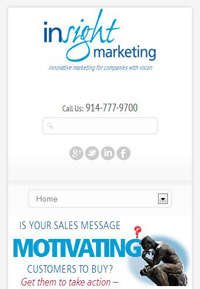Insight Marketing Blog
12 Characteristics of Great Print Advertising
 Volkswagen’s classic “Think Small” campaign still epitomizes great print advertising.
Volkswagen’s classic “Think Small” campaign still epitomizes great print advertising.With the glut of advertising and marketing that saturates our daily lives, yours must work hard to earn the customer’s attention. These 12 characteristics of great print advertising will help your next campaign do just that.
1. Keep It Simple – Less is better. One clear, compelling message is far more persuasive than a confused jumble of offers and benefits.
2. Stopping Power – Make your ad visually strong to capture the reader’s attention. You have only a second or two. If your advertising goes unnoticed, everything else is academic!
3. Clarity – Good advertising communicates quickly and convincingly. Readers won’t take the time to figure out a convoluted message – they’ll just move on.
4. What’s in it for me? – Customers want to know the benefit for them, not what’s important to you. If your ad headline says you’ve been in business for 25 years, you’re on the wrong track.
5. Frequency Matters – Your ad needs to run frequently to make an impression. Research says consumers need to see an ad three times before awareness is achieved and seven times before they’ll buy.
6. Size Matters – Larger ads have greater stopping power. Big ads also imply leadership.
7. Color Matters – Color dramatically increases the effectiveness of an ad.
8. Be Bold, Be different – Safe advertising is the riskiest advertising you can do as it’s unlikely to achieve great results.
9. Track Results – Advertising and retail pioneer John Wanamaker said, “I know half the money I spend on advertising is wasted, I just don’t know which half!” Use unique phone numbers, codes or other devices to determine which messages and/or media are performing best.
10. Budget Realistically – Most advertising fails because it’s under-funded. That’s like trying to fly across the Atlantic with only a half-tank of fuel. You’re going somewhere, but you’ll never reach your destination.
11. Use Humor – People want to be entertained. The most memorable advertising uses humor, like E-Trade’s Talking Baby or AFLAC’s slapstick duck.
12. Sex Sells – Used appropriately, sex does command attention: Think Victoria Secret and Calvin Klein.
How many of these characteristic does your advertising have?
Continue reading →Is There a Better Way to Measure ROI?

Is return on investment the only way to measure marketing effectiveness?
In marketing, we always stress return on investment, or ROI. But I recently read an article in Forbes that argues traditional ROI is no longer sufficient for evaluating your marketing efforts. To get a more accurate view, you have to move beyond the “hard” metric of money-earned-versus-money-invested, and consider “softer” metrics that aren’t always quantifiable.
The post, “Understanding the New ROI of Marketing” by Susan Gunelius, certainly got me thinking. It’s worth a read, but I’ll summarize its key points here, and add a few of my own observations.
What are these so-called “soft” metrics marketers should be watching? Let’s take a look:
Return on Impression
In its most basic sense, impressions refer to the number of customers or prospects who actually see your marketing. It’s a familiar concept in both internet marketing and traditional advertising. Knowing who’s looking quite simply tells you how far your message is reaching.
But Gunelius points out that there’s another facet to impressions: customer perceptions. After they see your marketing, what do they think and feel about your business? What do they say about it? Social media makes it particularly easy to follow conversations about your business or brand. Market research and surveys can also provide deeper insights into impressions.
Return on Opportunity
This has to do with weighing the “indirect” potential for a marketing piece against the time and resources it requires. Does the effort present an opportunity to create buzz or boost brand awareness? Can it help position your business in a way your competitors haven’t exploited? Or, referring back to impressions, does it have the potential to change the way customers perceive you? None of these can be counted in immediate dollars earned.
Return on Engagement
The term ‘engagement” gets tossed around a lot these days, especially in social media marketing, and some marketers have written it off as so much fluff. The way I see it, engagement is what businesses have been trying to do all along – create and nurture customer relationships. Content marketing, social media, customer service and even sales are just a few examples of efforts that support this.
Will your marketing strengthen your relationship with customers, which in turn encourages loyalty and great word of mouth? How are they responding to it?
Return on Objectives
Gunelius rightly notes that “not all goals are measurable with hard data.” Often you have to evaluate a marketing effort according to its effect on broader, long-term objectives.
For instance, a press release may not have an immediate financial impact. But it can be invaluable if it generates coverage that raises your profile or positions you as an authority. The same goes for web content like blog posts or case studies. You might also consider whether it’s helped reach the right audience, penetrate a new market or strengthened your positioning.
Including these new criteria may give you a clearer picture of your overall marketing effectiveness.
So what do you think? Will these “soft” metrics become commonplace, or will ROI always reign supreme?
Continue reading →
Make Your Website Mobile-Friendly with Responsive Design

Laptop, phone or tablet? Responsive design covers them all.
Try this quick experiment: Open a browser on your smart phone and find your company’s website. What do you see? Can you read the text without resizing? Can you navigate it easily?
Now imagine you’re a customer who’s staring at the same little screen. Can you find what you need quickly? Would you call this a convenient, useful experience – or is it a pain?
Once upon a time, all your business needed was a well-designed site that looked good on any old PC. That’s no longer the case, as mobile technologies change the way people interact with the web. Consider these facts:
- Last year PC sales dropped for the first time since 2000.
- Tablets are predicted to outsell laptops this year.
- Mobile internet usage has more than tripled since 2010, and shows no signs of slowing.
In a nutshell, that means more customers and prospects will be visiting your site through some kind of mobile device. If your site isn’t optimized for mobile, you’re making it harder for those people to do business with you. According to Google, 61% of mobile users said they’d skip to another site if they couldn’t find what they need “right away.” (They also felt “frustrated” and “annoyed” by companies that “wasted their time” with a bad mobile experience!)
So when my clients need a new website or a redesign, we talk about mobile, too. Using new coding techniques, we can build sites that look and work great wherever their customers choose to view them. It’s called responsive web design. Here’s what you need to know.
What is Responsive Web Design?

How our website looks to smartphone users.
With responsive web design, one site fits all. The website your customers see on their desktops is still the same one they see on a tablet or phone – with one important distinction. A responsive site adapts to the environment in which it’s being viewed. Your website detects the device in use and adjusts the layout and resolution to provide an optimal experience.
To see what I mean, visit insightmrktg.com on your smartphone (or resize your desktop browser to the same dimensions). Go ahead … I’ll wait. Now, at first glance you’ll notice a few things: our logo and contact number take center stage; the navigation shifts to a simple drop-down menu – easy to tap with a fingertip; the content is reformatted for easier viewing; and the sidebars drop to the bottom, below the key content we want you to read.
That’s responsive web design in action. Without it, our site would get crunched into an illegible mess, and you’d go blind or mad trying to use it. Not great for nurturing relationships.
Responsive Design vs. Mobile Websites
You may be saying to yourself, “Wait – don’t mobile websites already solve this problem?” In fact, you might have already invested in a mobile site (or sites) for your business. But the benefits of responsive design go beyond what you see on the screen, and in fact solve problems that mobile websites create:
More effective mobile SEO. You’d have to develop several mobile sites to suit all of the available screen sizes, and search engines have to crawl them all. With responsive design, search engines only crawl once, increasing the likelihood your content is indexed faster and search results are up-to-date. You also aren’t splitting valuable traffic between multiple sites. In addition, Google recently updated its search algorithms (Panda Update) to punish websites with lower search rankings if they have duplicate content. Visit Google Webmaster Tools to read more about responsive web design and mobile websites.
A consistent user experience. Whether customers find you on a phone, tablet or PC, the branding and user experience is the same. It’s familiar, and they know where to find the information they need. There’s no need for duplicate content or different URLs, which makes it easier for them to link to and share your content via social media.
It’s less work for you. One site to build, update and maintain. One SEO program to manage, with one comprehensive set of analytics. Which means lower costs and less time invested for you.
That’s not to say you should never invest in a mobile website. It all depends on the action you want visitors to take, and how that dovetails with the behaviors and needs of mobile users. If a mobile user wants to find a location nearby (retail), place a quick order (restaurants, pharmacies), change a reservation (travel) or make a last-minute appointment (healthcare, hair salons), a stripped-down mobile site designed around those tasks might provide a more streamlined experience.
But as responsive web design evolves, I think mobile sites will go the way of dial-up modems. And since we don’t know which direction mobile will go next – Google Glass? the iWatch? – I’d say responsive design is your business’s smartest bet.
How do you manage your customers’ mobile experience? Tell us in the comments below.
Photo courtesy of minyo73.
Continue reading →